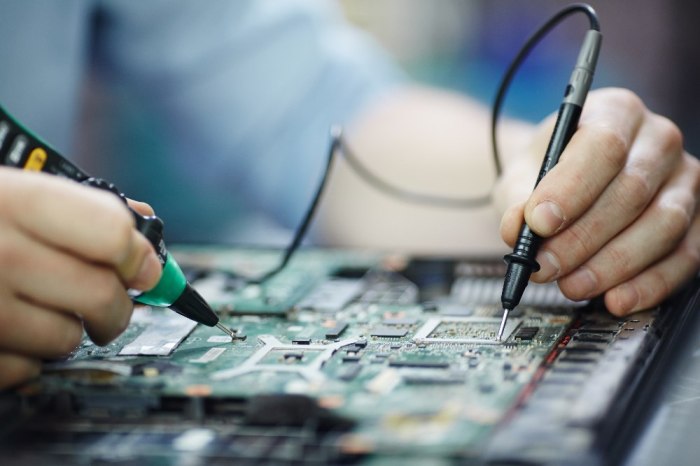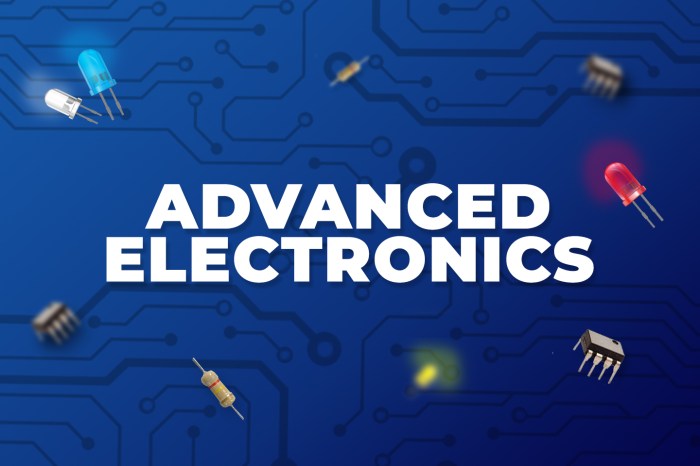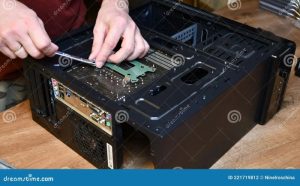
Advanced electronic components set the stage for an exciting journey into the world of modern technology. Get ready to dive deep into the evolution, functions, and impact of these cutting-edge components.
Introduction to Advanced Electronic Components
Advanced electronic components refer to the sophisticated and cutting-edge parts used in electronic devices, systems, and equipment. These components are designed to perform specific functions with high efficiency and precision.
The importance of advanced electronic components in modern technology cannot be overstated. These components form the backbone of various electronic devices we use in our daily lives, from smartphones and laptops to medical equipment and automotive systems. They enable faster processing speeds, increased storage capacity, improved energy efficiency, and enhanced performance overall.
Evolution and Advancements in Electronic Components
Over the years, electronic components have undergone significant evolution and advancements to meet the growing demands of the technology industry. Some key advancements include:
- Miniaturization: Advanced electronic components are increasingly smaller in size, allowing for more compact and portable devices.
- Integration: Components are now more integrated, combining multiple functions into a single chip or package.
- Efficiency: Advancements in materials and design have led to increased efficiency and reduced power consumption.
- Speed: Electronic components now operate at faster speeds, enabling quicker data processing and communication.
Types of Advanced Electronic Components
Advanced electronic components play a crucial role in the functioning of modern electronic devices. Let’s explore some of the key types of advanced electronic components and their functions.
Microprocessors
Microprocessors are essential components in electronic devices, acting as the brain of the system. They are responsible for executing instructions, performing calculations, and controlling the overall operation of the device.
- Function: Process data and perform calculations
- Applications: Found in computers, smartphones, tablets, and other electronic devices
- Features: High processing speed, multiple cores, cache memory
Sensors
Sensors are electronic components that detect changes in their environment and convert them into electrical signals. They play a crucial role in monitoring and controlling various parameters in electronic devices.
- Function: Detect changes in temperature, pressure, light, motion, etc.
- Applications: Used in IoT devices, automotive systems, medical equipment, etc.
- Features: Different types such as temperature sensors, motion sensors, proximity sensors
Capacitors
Capacitors store and release electrical energy in electronic circuits. They are vital for filtering noise, stabilizing voltage, and providing backup power in electronic devices.
- Function: Store and release electrical energy
- Applications: Filtering noise, smoothing voltage fluctuations, timing circuits
- Features: Different types like ceramic capacitors, electrolytic capacitors, tantalum capacitors
Integration of Advanced Electronic Components in Electronics and Electrical Systems

Advanced electronic components play a crucial role in the functioning of modern electronic and electrical systems. These components are seamlessly integrated into various devices to enhance their performance and functionality.
Smartphones
Smartphones are a prime example of electronic devices that heavily rely on advanced electronic components. These devices incorporate components such as processors, memory chips, sensors, and display screens. The integration of these components enables smartphones to perform a wide range of functions, from making calls to running complex applications seamlessly.
Electric Vehicles
Electric vehicles (EVs) are another example of devices that extensively use advanced electronic components. EVs rely on components like battery management systems, power electronics, electric motors, and control units for efficient operation. The integration of these components enables EVs to deliver high performance, increased range, and reduced emissions compared to traditional internal combustion engine vehicles.
Impact on Performance
The integration of advanced electronic components significantly impacts the performance and functionality of electronic systems. These components enable faster processing speeds, higher storage capacities, enhanced energy efficiency, and improved connectivity. As a result, electronic devices can perform complex tasks, operate more efficiently, and provide a better user experience.
Conclusion
In conclusion, the seamless integration of advanced electronic components in electronics and electrical systems has revolutionized the way we interact with technology. These components have paved the way for the development of innovative devices that offer enhanced capabilities and improved performance.
Role of Advanced Electronic Components in Data Communication

Advanced electronic components play a crucial role in enabling efficient data communication in today’s interconnected world. These components are essential for transmitting, receiving, and processing data across various networks and systems.
Advancements in Data Communication
- Advanced electronic components, such as high-speed processors and integrated circuits, have significantly improved data transmission speeds.
- The use of advanced components like fiber optics and high-frequency antennas has enhanced the reliability of data networks by reducing signal interference and loss.
- Components like routers, switches, and modems enable the seamless flow of data packets, ensuring smooth communication between devices.
Importance of Advanced Electronic Components in Data Networks
- Advanced electronic components are essential for establishing and maintaining data networks, ensuring efficient communication between devices.
- These components help in managing data traffic, allocating bandwidth, and ensuring the security of data transmissions within networks.
- Advancements in electronic components have enabled the development of complex data networks that can handle large volumes of data with minimal latency.
Enhanced Data Transmission Speeds
- With the use of advanced electronic components, data transmission speeds have increased significantly, allowing for faster communication between devices.
- Components like high-speed processors and advanced network interfaces enable quick data processing and transfer, reducing delays in data transmission.
- The integration of advanced components in data communication systems has revolutionized the way information is exchanged, making real-time communication possible across vast distances.
Advanced Electronic Components in Computer Repair and Consulting
When it comes to computer repair and consulting, advanced electronic components play a crucial role in diagnosing and fixing issues, as well as enhancing performance. Let’s delve into how these components are utilized and the common challenges faced in this field.
Use of Advanced Electronic Components in Repairing Computers
Advanced electronic components such as integrated circuits, transistors, resistors, capacitors, and diodes are essential in repairing computers. These components are used to replace faulty parts, troubleshoot hardware problems, and ensure the smooth functioning of the system.
Leveraging Components for Enhanced Performance
Computer consultants often leverage advanced electronic components to upgrade systems and enhance performance. By replacing outdated components with newer, more efficient ones, consultants can improve processing speed, memory capacity, and overall functionality of the computer.
Common Issues in Electronic Components for Computer Repair
- Overheating: One of the common issues in electronic components is overheating, which can lead to system crashes and hardware failures. Proper cooling mechanisms and component placement are crucial to prevent this issue.
- Power Supply Problems: Faulty power supplies can cause disruptions in computer operation and damage other components. Consultants need to accurately diagnose and replace defective power supply units to ensure system stability.
- Compatibility Issues: Different electronic components must be compatible with each other to function properly. Consultants need to be aware of compatibility issues and ensure that all components work seamlessly together.
- Component Failure: Electronic components can fail over time due to wear and tear or manufacturing defects. Identifying and replacing failed components is a key aspect of computer repair and consulting.
Advanced Electronic Components in Computers Hardware
Advanced electronic components play a crucial role in the development of computer hardware, contributing to the efficiency and speed of modern computers. These components are essential in ensuring the seamless functioning of various hardware components within a computer system.
Central Processing Unit (CPU)
The CPU is often considered the brain of the computer, responsible for executing instructions and performing calculations. Advanced electronic components such as transistors, resistors, and capacitors are integrated into the CPU to enhance its performance and processing speed. For example, the use of multicore processors and advanced microarchitecture design has significantly improved the processing power of modern CPUs.
Graphics Processing Unit (GPU)
The GPU is essential for rendering graphics and images on a computer screen. Advanced electronic components like Graphics Processing Units (GPUs) are equipped with thousands of processing cores that enable complex calculations required for high-quality graphics rendering. The use of advanced GPU architectures, such as NVIDIA’s CUDA cores or AMD’s RDNA 2 architecture, has revolutionized graphics processing in computers.
Random Access Memory (RAM)
RAM is a type of volatile memory that temporarily stores data and instructions for the CPU to access quickly. Advanced electronic components in RAM modules, such as DRAM (Dynamic Random Access Memory) chips, ensure fast data transfer rates and low latency. Technologies like DDR4 and DDR5 have increased the memory bandwidth and capacity of RAM, improving overall system performance.
Solid State Drives (SSDs)
SSDs are storage devices that use advanced electronic components like NAND flash memory to store data. Compared to traditional hard drives, SSDs offer faster read and write speeds, lower power consumption, and enhanced durability. The use of advanced NAND flash technology, such as 3D NAND and TLC (Triple-Level Cell) architecture, has made SSDs the preferred storage choice for modern computers.
Advanced Electronic Components in Graphics and Multimedia
Advanced electronic components play a crucial role in enhancing the quality and performance of graphics and multimedia applications. These components have revolutionized the way we experience visual and audio content, making them more immersive and engaging.
Impact of Advanced Electronic Components on Graphics and Multimedia
Advanced electronic components have significantly improved the quality of graphics and multimedia content by enabling faster processing speeds, higher resolutions, and more realistic visual effects. These components have made it possible to render complex graphics and videos with greater detail and precision, providing users with a more immersive viewing experience.
Enhancement of Visual and Audio Quality
- Advanced electronic components such as GPUs (Graphics Processing Units) and sound cards enhance the visual and audio quality of multimedia content by enabling high-definition graphics and crystal-clear sound.
- These components allow for real-time rendering of graphics and videos, resulting in smoother animations, sharper images, and more realistic audio effects.
- They also support advanced technologies like 3D rendering, virtual reality, and surround sound, further enhancing the overall multimedia experience.
Role in Rendering Complex Graphics and Videos
- Advanced electronic components are essential for rendering complex graphics and videos, as they provide the processing power needed to handle large amounts of data and perform intricate calculations.
- Components like graphics cards and video processing units (VPUs) are specifically designed to accelerate the rendering of high-quality visuals, enabling the creation of detailed 3D models, lifelike animations, and high-resolution videos.
- These components work seamlessly with software applications to optimize performance and deliver stunning graphics and videos in real-time, making them ideal for gaming, video editing, animation, and other multimedia-intensive tasks.
Wrap-Up
In conclusion, advanced electronic components play a crucial role in shaping the future of electronics, data communication, computer hardware, and multimedia. Their significance cannot be overstated in today’s tech-driven world.
General Inquiries
What are advanced electronic components?
Advanced electronic components are complex parts used in electronic devices to perform specific functions, such as microprocessors, sensors, and capacitors.
How do advanced electronic components impact data communication?
These components play a vital role in establishing and maintaining data networks, leading to faster and more reliable data transmission.
What role do advanced electronic components play in computer repair?
Advanced electronic components are essential in repairing computers and enhancing their performance, often used by consultants to troubleshoot issues.




